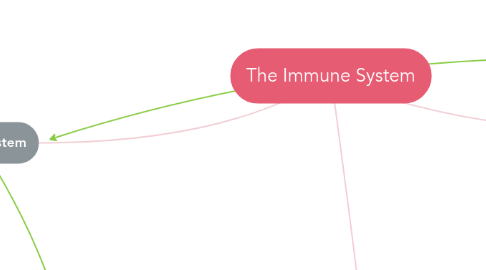
1. Adaptive Immune System
1.1. Lymphocytes
1.1.1. B cells
1.1.1.1. Form and mature in the bone marrow via stem cells
1.1.1.1.1. Move to lymphatic system to look for antigens that match the B cell's membrane-bound antibody
1.1.1.2. Make antibodies, neutralize pathogens, signal to microphages
1.1.1.2.1. Microphages eat viruses or bacteria
1.1.2. T cells
1.1.2.1. Killer T-Cells (Cytotoxic)
1.1.2.1.1. Kill infected cells and release cytokines
1.1.2.2. Helper T-cells
1.1.2.2.1. Tell Killer T-Cells and B-Cells to do their jobs
1.1.2.3. Creation Process
1.1.2.3.1. Form in bone marrow via stem cells
1.1.2.4. T-Cell Receptors
1.1.2.4.1. Plus CD4 or CD8 receptors
1.2. Lymphatic System
1.2.1. Lymphoid Organs
1.2.1.1. Allow for movement of lymph
1.2.1.1.1. Tonsils
1.2.1.1.2. Lymphoid tissue
1.2.1.1.3. Appendix
1.2.1.1.4. Lymph Nodes
1.2.1.1.5. Spleen
1.2.1.1.6. Lymphatic vessels
2. Immune system failures and cures
2.1. Allergies
2.1.1. Failure to edit out "not dangerous" B-Cells
2.2. Vaccines
2.2.1. Made of all/part of pathogen, allow B/T cells to develop a memory of that disease to be prepared next time
2.3. Antibiotics
2.3.1. Medicine used to fight bacterial infections
2.3.1.1. Studies have shown that they hurt the immune system, as they weaken the body's ability to fight off the bacteria naturally, instead of working with immune system as intended
2.3.1.1.1. Bacteria can build up antibiotic resistance and mutate to be protected from antibiotics
2.4. Immunodeficiency Disorders
2.4.1. Prevent your body from fighting infections and disease and makes you more susceptible to diseases
2.5. Autoimmune diseases
2.5.1. A condition in which your immune system creates antibodies that mistakenly attack your body instead of fighting infections
2.6. Immunotherapy
2.6.1. Boosts immune system to help it identify and attack cancers
3. Innate Immune System
3.1. Always nonspecific-- any non-self substances are targets
3.1.1. General Immune Responses
3.1.1.1. Non-specific inflammation or complement
3.1.2. Physical Barriers
3.1.2.1. Includes skin, body hair, cilia, gastrointestinal and respiratory tracts, etc.
3.1.3. Defense Mechanisms
3.1.3.1. Includes mucous, bile, secretions, saliva, tears, sweat, and gastric acid
3.2. White blood cells (leukocytes) travel via the circulatory system
3.2.1. Phagocytes, or Phagocytic Cells
3.2.1.1. "Eating cells" that spread throughout the body looking for threats to engulf and destroy
3.2.2. Macrophages
3.2.2.1. Can roam outside of circulatory system to hunt pathogens. Antigen-presenting
3.2.3. Mast Cells
3.2.3.1. In mucous membranes and connective tissue
3.2.3.1.1. Wound healing and pathogen defense.
3.2.4. Neutrophils
3.2.4.1. Have toxic granules that kill/sterilize bacteria and fungi
3.2.5. Eosinophils
3.2.5.1. Target multicellular parasites via secretion of very toxic proteins and free radicals
3.2.5.1.1. These secretions cause tissue damage during allergic reactions, so are very regulated
3.2.6. Basophils
3.2.6.1. Attack multicellular parasites
3.2.6.1.1. Release histamine, similar to Mast Cells
3.2.7. Natural Killer Cells
3.2.7.1. Destroy infected host cells to stop spread of infection
3.2.7.1.1. Called by infected cells via antigen presentation or display of specific receptors
3.2.8. Dendritic Cells
3.2.8.1. Antigen-presenting cells found in tissues that can contact external environments that are commonly points of initial infection
3.2.8.1.1. Identify threats and act as immune system messengers via antigen presentation

